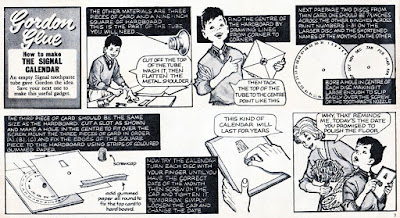A few months ago I bought a few pieces of Roy Wilson artwork so I thought I'd show them here. In case you didn't know, Roy Wilson (1900 to 1965) was the most influential artist working in British humour comics from the 1930s to the early 1950s. His lively, fluid, friendly style became the house style for The Amalgamated Press, with many artists being told to emulate him. (And many did a fantastic job of it too!) Even years later, his style influenced that of Robert Nixon, and myself to a lesser extent.
In those days of British comics, when narrative text was glued under each panel, pages were drawn in separate tiers. Sometimes each panel was supplied to the editor as individual pictures. (This is why veteran artists would refer to "a set of drawings" when talking about a comics page.) The remarkable thing about Roy Wilson is that he was such a perfectionist that he'd often discard drawings part way through, and it's those which have ended up on eBay.
The three panel tier below is a section of Happy Andy and his Pets from Tip-Top comic in the 1940s. It's interesting to see Wilson's drawing technique had him ink certain parts first, rather than panel by panel. For some reason he must have been dissatisfied with panels two and three, even though I'm sure they look perfect to our eyes. (To give you an idea of the size these old strips were drawn, the width of the artwork of this row is 18 and a half inches, not including margins.) Click on the images to see them larger.
Here's the panels in larger detail. Like most artists of the time, Wilson did his own lettering. (Lettering directly onto the art is something I've always preferred, and enables the artist to have control of the panel composition instead of leaving dead areas only to find the balloons stuck elsewhere.)
These next two panels are from Marmaduke and His Ma from The Funny Wonder in the 1940s. This has the word "Urgent!" written on the reverse, and the editor's note for resizing the panel for publication so I'm guessing this was used and not rejected. Perhaps the "Urgent" note suggests it was to replace two other panels, and the editor had requested the redraw?
These final panels are from the strip The Adventures of Reg Varney as a Boy that began in TV Fun in 1955. Again, the first version looks perfect, but by the second version we can see several subtle improvements that add more personality to the characters. For whatever reason, Wilson must have also been unhappy with the second one too as it's also unfinished. (If anyone has the published version I'd like to see a scan to see what the final redraw was like.)
This last unfinished panel is also from the Reg Varney strip, although possibly a different week. Again, beautiful artwork, but Wilson must have felt he could improve on it.
Remarkably, despite the importance of Roy Wilson's work, and the beauty of these unfinished pieces, the prices were very reasonable, at around £20 each! Sadly as the years have passed, artists such as these become forgotten or ignored by newer collectors. This blog won't be here forever, but while it is, I hope it helps keep the work of these greats alive for modern readers to discover.
In those days of British comics, when narrative text was glued under each panel, pages were drawn in separate tiers. Sometimes each panel was supplied to the editor as individual pictures. (This is why veteran artists would refer to "a set of drawings" when talking about a comics page.) The remarkable thing about Roy Wilson is that he was such a perfectionist that he'd often discard drawings part way through, and it's those which have ended up on eBay.
The three panel tier below is a section of Happy Andy and his Pets from Tip-Top comic in the 1940s. It's interesting to see Wilson's drawing technique had him ink certain parts first, rather than panel by panel. For some reason he must have been dissatisfied with panels two and three, even though I'm sure they look perfect to our eyes. (To give you an idea of the size these old strips were drawn, the width of the artwork of this row is 18 and a half inches, not including margins.) Click on the images to see them larger.
Here's the panels in larger detail. Like most artists of the time, Wilson did his own lettering. (Lettering directly onto the art is something I've always preferred, and enables the artist to have control of the panel composition instead of leaving dead areas only to find the balloons stuck elsewhere.)
These next two panels are from Marmaduke and His Ma from The Funny Wonder in the 1940s. This has the word "Urgent!" written on the reverse, and the editor's note for resizing the panel for publication so I'm guessing this was used and not rejected. Perhaps the "Urgent" note suggests it was to replace two other panels, and the editor had requested the redraw?
Remarkably, despite the importance of Roy Wilson's work, and the beauty of these unfinished pieces, the prices were very reasonable, at around £20 each! Sadly as the years have passed, artists such as these become forgotten or ignored by newer collectors. This blog won't be here forever, but while it is, I hope it helps keep the work of these greats alive for modern readers to discover.

















































